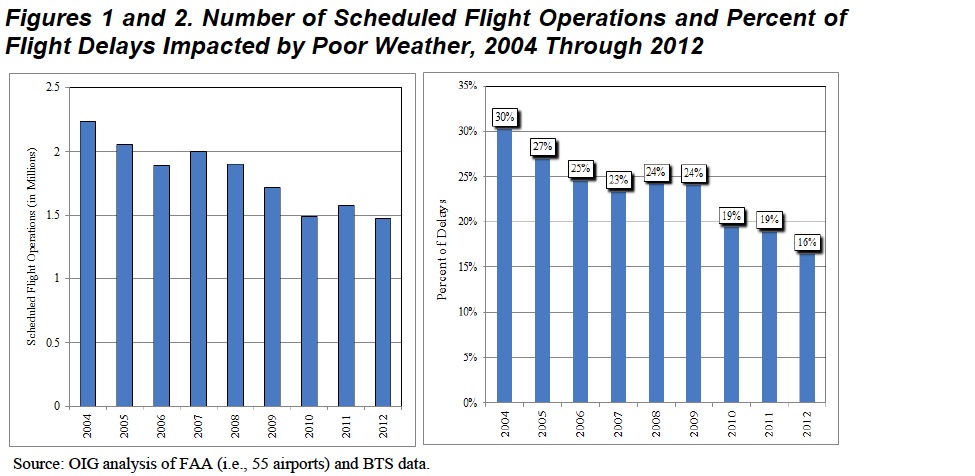UNITED STATES DEPARTMENT OF TRANSPORTATION
OFFICE OF THE INSPECTOR GENERAL
Good Weather, New Infrastructure, Revised ATC Procedures, and Reduced Flight Schedules Have All Helped Reduce Flight Delays
Favorable Conditions Have Reduced the Impact of Weather on Flight Delays
Weather has always been a major factor in causing flight delays and cancellations—as most recently emphasized by Hurricane Sandy in 2012, which shut down many of the major airports in the northeast United States, resulting in more than 20,000 cancelled flights. Notwithstanding this event, relatively favorable weather conditions over the last few years have contributed to the reduced number of delays across most of the country. For example, as illustrated in figures 1 and 2, over 2.2 million scheduled operations (that is, arriving and departing flights) were impacted by poor weather in 2004, compared with approximately 1.5 million scheduled operations in 2012—a decline of 34 percent. Likewise, as shown in figure 2, the percent of flight delays due to poor weather also declined from a high of 30 percent in 2004 to the current low of only 16 percent in 2012.
Nevertheless, BTS believes weather has a larger impact on delays than currently reported by air carriers, and has recently conducted a study to determine the extent that weather causes delays. As part of this effort, BTS is working with FAA to include the results of their research in an expanded version of publicly available causal delay statistics. BTS reports it has completed its initial study; however, more work is needed before any information can be presented to the public. Moreover, according to BTS, additional funding will be necessary to complete development and deployment of these data, and given current budget limitations, the project is not likely to move forward at this time.
New Airport Infrastructure and ATC Procedures Have Helped Reduce Flight Delays
New infrastructure has helped reduce flight delays at many of the Nation’s busiest airports. Since 2000, 20 major airports previously designated by FAA as most critical to improving the capacity and efficiency of the National Airspace System (NAS) have completed substantial runway or taxiway projects that have served to increase capacity or improve traffic flows. For example, Atlanta—which added a fifth runway in 2006 and a new taxiway in 2007—experienced a 37 percent decrease in delays between 2000 and 2012. Similarly, Denver opened a new runway in September 2003 and experienced a 21 percent decrease in delays, even though the number of scheduled flights increased 22 percent between 2000 and 2012. While these numbers illustrate the beneficial impacts of infrastructure improvements on flight delays, several of the Nation’s major airports with continuing congestion concerns (i.e., LaGuardia, Newark, San Francisco, and Boston) face significant challenges in adding new airfield infrastructure because of factors such as space constraints and environment concerns.
Air traffic control improvements have also helped reduce delays. For example, at Atlanta Hartsfield airport, a number of procedural changes have been implemented. These improvements, such as increased runway separation procedures, allow for the departure of three aircraft, whereas previously only two could depart simultaneously. Similarly, the Port Authority of New York/New Jersey has implemented a departure metering system that has helped decrease taxi times and reduced air carrier fuel costs.
About the USDOT Office of the Inspector General
oig.dot.gov
“The Office of Inspector General is committed to fulfilling its statutory responsibilities and supporting members of Congress, the Secretary, senior Department officials, and the public in achieving a safe, efficient, and effective transportation system.”
Tags: Air travel, airports, FAA, Federal Aviation Administration, Office of the Inspector General, Office of the Secretary of Transportation, Research and Innovative Technology Administration, RITA, United States Department of Transportation







 RSS Feed
RSS Feed